
Italian postcard, no. 2020. Lyda Borelli and Amleto Novelli in Malombra (Carmine Gallone, 1917).
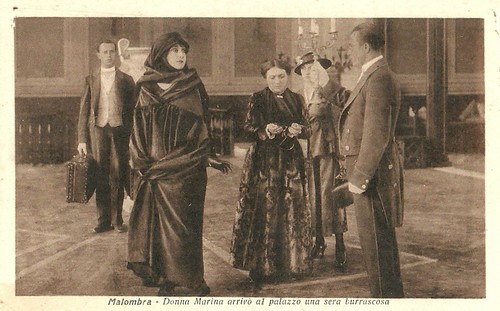
Italian postcard by IPA CT Duplex. Photo: Film Cines. Publicity still for Malombra (Carmine Gallone, 1917). Caption: Donna Marina (Lyda Borelli) arrived at the castle on a tempestuous night.

Italian postcard by IPA CT Duplex. Photo: Film Cines. Publicity still for Malombra (Carmine Gallone, 1917), starring Lyda Borelli. Caption: Count Cesare d'Ormengo (Augusto Mastripietri) and his secretary Mr. Steinegge (Amedeo Ciaffi) let Donna Marina visit the castle and its neighbourhoods.

Franco-Italian postcard by IPA CT Duplex. Photo: Film Cines. Publicity still for Malombra (Carmine Gallone, 1917). Caption: Declaration [of love]. Left Edith Steinegge (Consuelo Spada) and right Corrado Silla (Amleto Novelli).

Italian postcard by IPA CT Duplex. Photo: Film Cines. Publicity still for Malombra (Carmine Gallone, 1917). Caption: The first encounter of Donna Marina di Malombra with Corrado Silla.
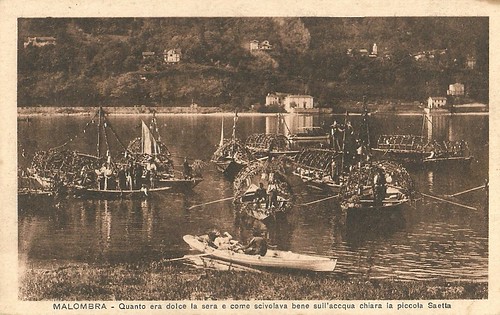
Italian postcard by IPA CT Duplex. Photo: Film Cines. Publicity still for Malombra (Carmine Gallone, 1917), with, in the front, Lyda Borelli. Caption: How sweet was the night and how well little Saetta slipped on the clear water.

Italian postcard by IPA CT Duplex. Photo: Film Cines. Publicity still for Malombra (Carmine Gallone, 1917), starring Lyda Borelli. Caption: ...Saetta seized [the oars] and left, moving towards some solitary shore.
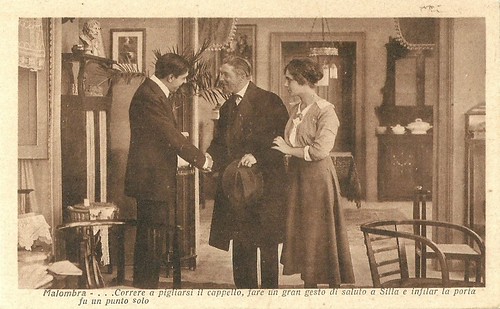
Italian postcard by IPA CT Duplex. Photo: Film Cines. Publicity still for Malombra (Carmine Gallone, 1917). Caption: He hurried to grab his hat, have a grand farewell gesture to Silla and open the door all at once.
Gothic melodrama
Lyda Borelli (1887-1959) was already an acclaimed stage actress before she became the first diva of the Italian silent cinema. One of her most important films is Malombra (1917), a gothic melodrama, set at Lake Como at the castle Malombra.
The young, orphaned countess Marina di Malombra (Borelli) comes to live with her uncle, Count d'Ormengo (Augusto Mastripietri). She chooses as her apartment the one overseeing the lake, though considered 'doomed' by the staff.
While at the castle, she meets the German secretary Steinegge (Amedeo Ciaffi), and the young writer Corrado Silla (Amleto Novelli). Silla is close with the count and Steinegge but he is also fond of the secretary's daughter, the bashful Edith (Consuelo Spada).
One night, during a Spring festival, Marina drifted on the lake and is showered with flowers by the locals. When she comes back to her room, she finds by accident a secret drawer, discovers a glove, a lock of hair, a mirror and a diary. These objects belonged to her ancestor Cecilia, the first wife of her uncle's father.
Marina identifies herself with Cecilia, who died imprisoned after adultery. Marina thinks Cecilia has reincarnated in her, and she considers the count as the heir of his father's wrongdoings and therefore guilty. She startles the count with her accusations. Meanwhile, Silla, author of the book 'A Dream', which Marina has been fascinated by, has written Marina letters addressed to 'Cecilia'.

Italian postcard by IPA CT Duplex. Photo: Film Cines. Publicity still for Malombra (Carmine Gallone, 1917). Caption: Remember the night of 10 January 1797 in Genoa... Remember the white rose at the Doria ball.

Italian postcard by IPA CT Duplex. Photo: Film Cines. Publicity still for Malombra (Carmine Gallone, 1917). Caption: Donna Marina took possession of the dwelling of the Ghosts.
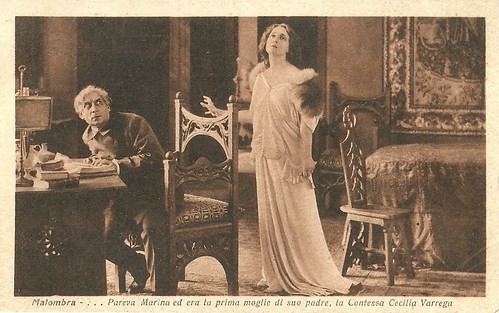
Italian postcard by IPA CT Duplex. Photo: Film Cines. Publicity still for Malombra (Carmine Gallone, 1917). Caption: It looked as if Marina was the first wife of his father, Countess Cecilia Varrega.

Italian postcard by IPA CT Duplex. Photo: Film Cines. Publicity still for Malombra (Carmine Gallone, 1917). Caption: The presence of Count Cesare was the most terrible torture to her.
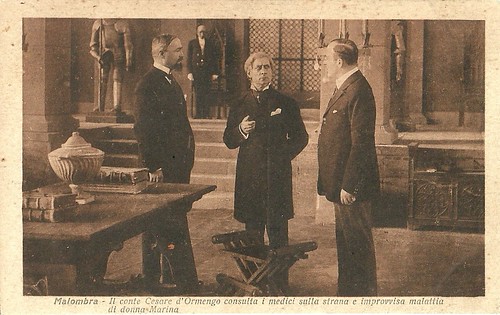
Italian postcard by IPA CT Duplex. Photo: Film Cines. Publicity still for Malombra (Carmine Gallone, 1917). Caption: Count Cesare d'Ormengo consulted the doctors on the strange and unexpected illness of Donna Marina.

Italian postcard by IPA CT Duplex. Photo: Film Cines. Publicity still for Malombra (Carmine Gallone, 1917). Caption: He looked at Marina with his big myopic, bulging eyes.
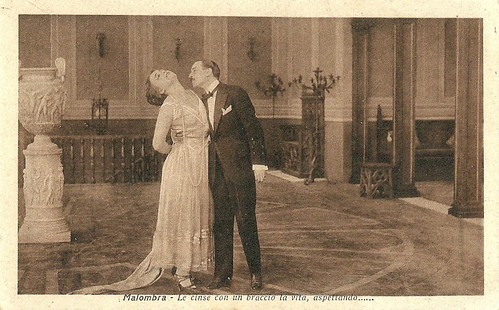
Italian postcard by IPA CT Duplex. Photo: Film Cines. Publicity still for Malombra (Carmine Gallone, 1917). Caption: He held her with one arm by the waist, hoping...
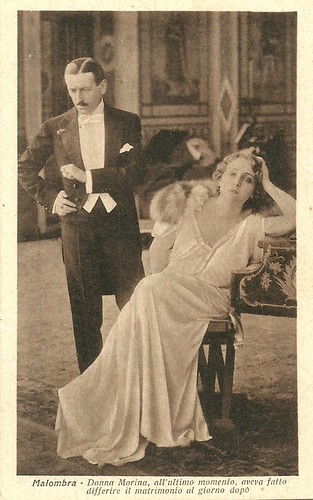
Italian postcard by IPA CT Duplex. Photo: Film Cines. Publicity still for Malombra (Carmine Gallone, 1917). Caption: At the last moment Donna Marina had managed to postpone the marriage to the next day.
A hysterical fit
Her uncle tries to distract Marina by inviting friends and tries to match her with Count Salvador (Francesco Cacace), a pale, cowardly aristocrat. Marina dislikes Salvador, which she repeatedly expresses during a dinner party and an excursion. One night, while Marina's uncle has become mortally ill, Silla lands on the shore of the castle and is head over heels in love with Marina, who by now has lost her wits.
He first plays along with her that she is Cecilia's reincarnation, just to make love to her. When Marina discovers Silla only pretended she was Cecilia, she storms into the bedroom of the Count, who is dying. In a hysterical fit, she shouts that she hates him. Silla carries her away. The count dies, too weak to have heard Marina's accusations.
The next day Marina calms down, so much that the doctors allow her a last caprice: a nightly dinner in the loggia of the castle, all adorned with flowers. A storm rises but the dinner proceeds. The doctors discover Marina hasn't recovered. Moreover, she kills Silla and flees with a boat on the stormy lake, towards a mortal vortex.
The Como Lake was also the site where the young Luchino Visconti passed his holidays. The 9-year-old Luchino had read the novel Malombra and had also seen the film version with Borelli. The romantic boy was fascinated by the story and by sunset, he always took his little boat to visit the shores of the lake.
The last scene of the novel is not visible in the surviving print of the film. In this silent version, the affair between Edith and Silla is not very prominent, in contrast to the book and the later 1941 sound version, directed by Mario Soldati and featuring Isa Miranda as Marina di Malombra.

Italian postcard by IPA CT Duplex. Photo: Film Cines. Publicity still for Malombra (Carmine Gallone, 1917). Caption: Nepo (Francesco Cacace) went to place himself next to Marina.

Italian postcard by IPA CT Duplex. Photo: Film Cines. Publicity still for Malombra (Carmine Gallone, 1917), starring Lyda Borelli, Amleto Novelli (both left) and Augusto Mastripietri (in bed). Caption: One noticed Silla throwing himself on her, lifting her with his arms.

Italian postcard by IPA CT Duplex. Photo: Film Cines. Publicity still for Malombra (Carmine Gallone, 1917). Caption: She still had two or three convulsed sobs, without tears...

Italian postcard by IPA CT Duplex. Photo: Film Cines. Publicity still for Malombra (Carmine Gallone, 1917). Caption: I don't know nothing, I remember nothing. I never lived, never apart from now. I knew only you would come, this moment. I have the frenzy to enjoy it.

Italian postcard by IPA CT Duplex. Photo: Film Cines. Publicity still for Malombra (Carmine Gallone, 1917). Caption: For a moment he laid his hands on her arm. She shivered: her shoulders and her breasts lifted themselves.

Italian postcard by IPA CT Duplex. Photo: Film Cines. Publicity still for Malombra (Carmine Gallone, 1917). Caption: ... she fell almost supine in an armchair.

Italian postcard by IPA CT Duplex. Photo: Film Cines. Publicity still for Malombra (Carmine Gallone, 1917). Caption: Here, she said, signing him to sit down on the ground next to her. All your memories...
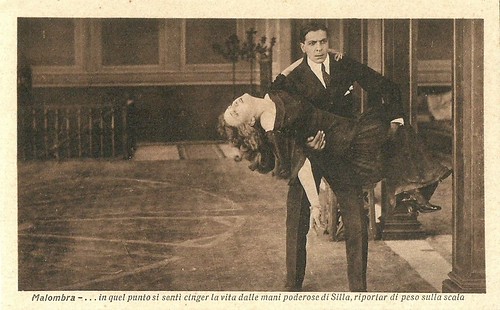
...at that moment she felt her waist held by the powerful hands of Silla, who lifted her back up the stairs.
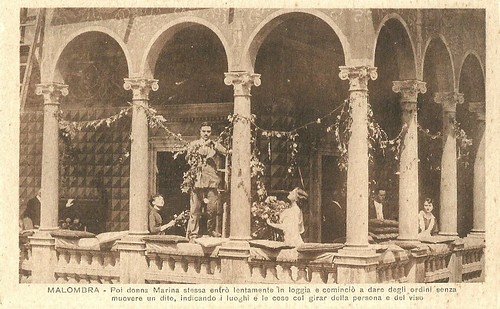
Italian postcard by IPA CT Duplex. Photo: Film Cines. Publicity still for Malombra (Carmine Gallone, 1917). Caption: Then Donna Marina herself slowly entered the loggia and started to give orders without moving a finger, pointing at the places and things by the turning of her body and her face.
Sources: Laurence Schifano (Visconti, une vie exposée - French), Wikipedia and IMDb.
This post was last updated on 10 July 2023.
No comments:
Post a Comment